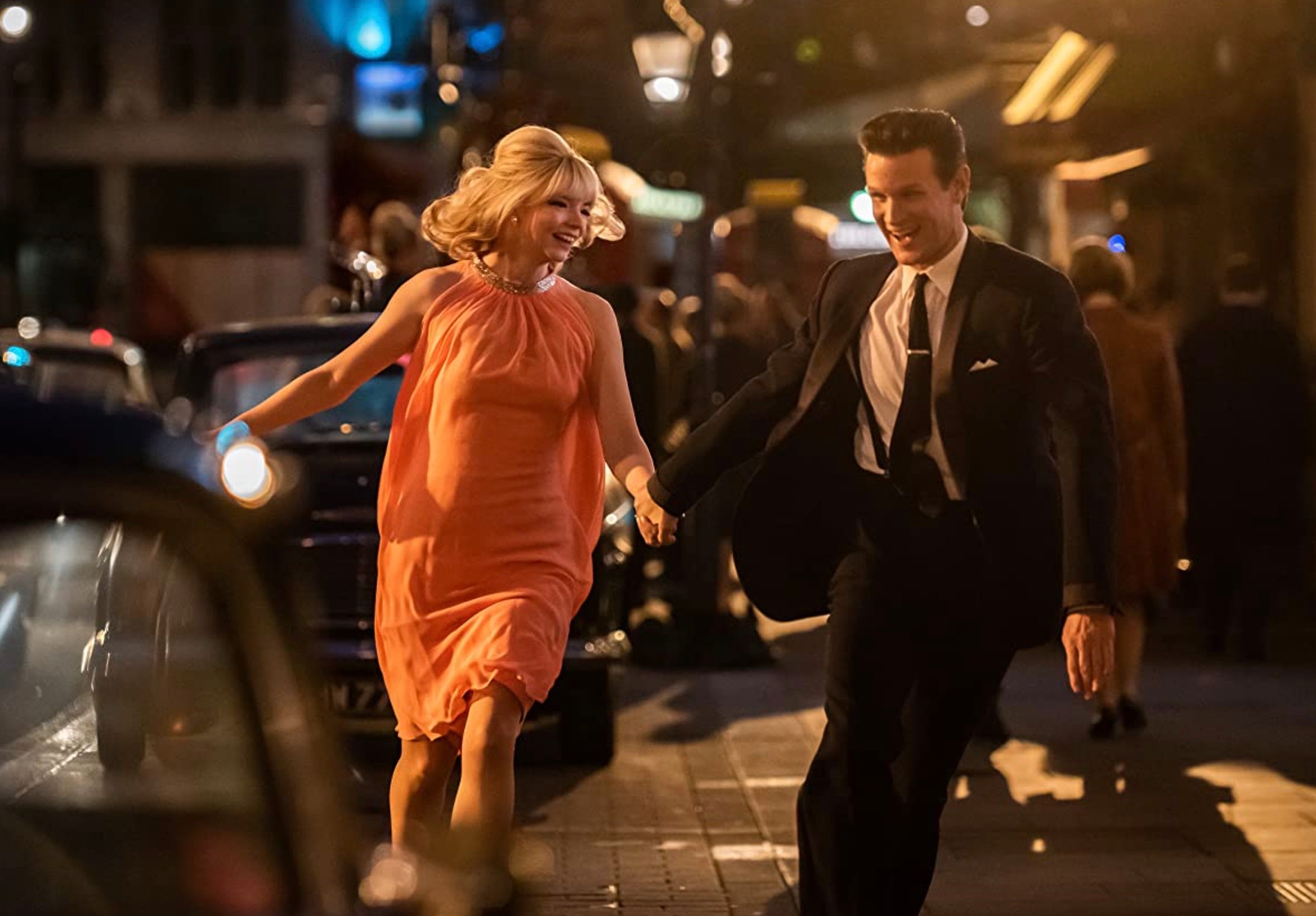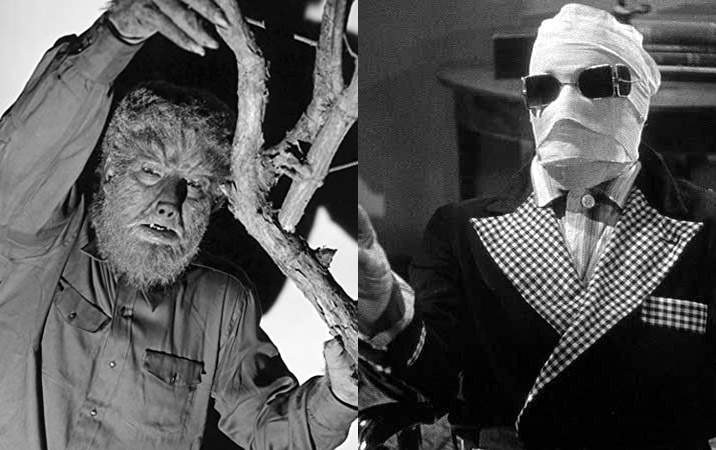
Matt Smith and Anya Taylor-Joy in Last Night in Soho / Working Title Films
You can always count on director Edgar Wright to mine something unique and often dazzling even while toiling in familiar territory. His latest film “Last Night in Soho” is the perfect example.
Wright takes would could’ve been just another sleazy murder mystery, and crafts it into something hauntingly different, character driven and far more interesting.
This review will be light on the plot details to make sure not to spoil any of the fun that’s to be had with this well-crafted tale about Ellie, (Tomasin McKenzie) a first-year fashion student from the country, who finds herself overwhelmed upon moving to London to attend college.
All-night parties and catty dorm mates push Ellie, whose mother committed suicide when the girl was just 7, to seek refuge in an upper apartment of a Soho townhouse, owned by an elderly woman Ms. Collins (Diana Rigg in her final role before dying Sept. 10). Ellie is enamored with the culture and kitsch of mid-1960s London. It shows in her own style and designs, which seems a bit backward to her classmates.
However, her love of the Mod era begins to twist its way into her dreams the night she moves into her new apartment. She begins to enjoy escaping in her favorite time period through her dreams as she takes on the persona and look of a lovely young bird named Sandie (Anya-Taylor-Joy) who aspires to be a singer.
At first, Ellie can’t wait to enter her dreamscape as Sandie, where she sings and performs in a swanky nightclub as well as cavorts with her stylish hipster boyfriend Jack (Matt Smith). Ellie even turns down a date with John (Michael Ajo), a classmate who fancies her, in order to escape back to her room so she can live vicariously through Sandie in her slumber.

Thomasin McKenzie in Last Night in Soho / Working Title Films
However, her dreams and Sandie’s story begin to turn ugly, and the ugliness soon begins to overflow into Ellie’s actual life as she struggles with telling the difference between her nighttime fantasies and her actual life, causing all manner of problems.
The central question for the audience at this point is whether Ellie is losing her mind, being haunted, or both? The resolution of that question composes the final act, which I did not see coming, probably because I was so enamored by Wright’s sense of style and visual storytelling that grabbed me the moment the film’s setting shifted to London and never let me go.
I was so enthralled by the story being told that I wasn’t playing movie detective as I normally like to do. That’s a credit to Wright and his cast because rarely am I ever that engrossed in a story.
This film should lift McKenzie’s star profile. She really makes you feel for Ellie and the trouble she unwittingly courts when her passion for a time period leads her along a haunting path.
Taylor-Joy is strong as always as Sandie, who ends up not being quite as tough and worldly wise as she pretends, but all the more dangerous. Rigg’s part winds up being a doozy, and if you are a good sleuth, you’ll likely suss out where the film is headed with her character before I did.
Smith is appropriately sleazy as Jack, and while Terrence Stamp’s character winds up being a MacGuffin of sorts, his gravitas adds flavor to the film.
The final act of the movie delves into gruesome, gory, and super-natural territory the befits its “R” rating.
(R) 1 hr. 56 min.
Grade: B+
New in Local Theaters
• Last Night in Soho (watch trailer) / (R) 1 hr. 56 min. / AMC Fiesta Square, Malco Razorback, Malco Springdale, Malco Towne
• Antlers (watch trailer) / (R) 1 hr. 39 min. / AMC Fiesta Square, Malco Razorback, Malco Springdale, Malco Pinnacle
• 13 Minutes (watch trailer) / (PG-13) 1 hr. 49 min. / AMC Fiesta Square
• A Mouthful of Air (watch trailer) / (R) 1 hr. 45 min. / Malco Razorback
• My Hero Academia: World Heroes Mission (watch trailer) / (PG-13) 1 hr. 44 min. / Malco Razorback, Malco Pinnacle
Classic Corner – The Invisible Man / The Wolf Man (Malco Razorback Cinema)

Universal Pictures
To get film fans in the mood for Halloween, Fathom Events and the Malco Razorback Cinema are offering a one-time showing of two classics from Universal Pictures’ horror library at 1 p.m. Saturday with the original versions of “The Invisible Man” from 1933 and “The Wolf Man” from 1941.
The Invisible Man (1933)
On the heels of his success with 1931’s “Frankenstein” and 1932’s “The Old Dark House,” director James Whale fashioned another horror classic by adapting H.G. Well’s “The Invisible Man” for the cinema in 1933.
It’s the story of a a brilliant research scientist Dr. Jack Griffin (Claude Rains) who is driven mad after experimenting with a drug called monocane. However, the drug not only drives him crazy, it also turns him invisible.
Rains, who was struggling as a stage performer in New York during the height of the Great Depression when cast, gives a manic and daft performance as Griffin that set him on the way to being one of the most respected character actors during the glory days of Hollywood.
Rains went on to play key supporting roles in such classics as “The Adventures of Robin Hood” (1938), “Mr. Smith Goes to Washington” (1939), “The Wolf Man (1941), “Casablanca” (1942), “Notorious” (1946), “Lawrence of Arabia (1962), and “The Greatest Story Ever Told” (1965), but “The Invisible Man” stands out as perhaps his best leading role.
As memorable as Rains is, the film’s special effects are the star. Incredibly, they stand up to scrutiny nearly 90 years later. The scene where Rains gleefully first removes the bandages from his face must have shocked audiences in the 1930s. Modern film fans have seen a similar effect repeated dozens of times since, but the camera work and effects in the original still work beautifully.
As with most of Whale’s horror movies, the director adds in a dose of humor. Fans of “The Bride of Frankenstein” will notice Una O’Connor as the the inn keeper. Universal horror film journeyman Dwight Frye, who had roles in “Frankenstein,” Dracula” among others, shows up here as a reporter. Walter Brennan and John Carradine also have small roles in the movie before going on to better character roles in scores of films.
The Wolf Man
“The Wolf Man” isn’t the best of the classic Universal horror pictures. That’s “The Bride of Frankenstein.” However, the story of Larry Talbot, who turns into a wolfish fiend when the full moon rises, is one of the most influential films on current pop culture.
Certainly, every subsequent movie featuring werewolves owes some debt to the 1941 classic that opened the same weekend that Japan bombed Pearl Harbor, but the roots of today’s most popular films — Marvel movies — rest firmly in the Wolfman’s paws.
Marvel Comics editor/writer Stan Lee, who filled word balloons around all of that fabulous Jack Kirby and Steve Ditko art in the 1960s, was clearly a monster-movie fan, and in particular of the Wolf Man, as portrayed by Lon Chaney Jr.
Read characters like the Hulk, Spider-Man, and Daredevil and the pathos that underpins their heroic adventures were no doubt cribbed from the plight of Larry Talbot as conceived by journeyman screenwriter Curt Siodmak.
The major differentiating factor between Marvel super heroes and those published by DC Comics in the 1960s was that Lee and co-plotters/artists Kirby and Ditko grounded the Marvel characters with problems that stemmed not only from every-day life but also particular issues created by living double lives as super heroes. This made Marvel characters hip, cool, and real compared to the stayed, single-note characterizations of DC characters of the same period. Lee, a huge movie buff, lifted this idea from Siodmak’s Wolf Man scripts. I’ll let you be the judge on whether he did it subconsciously or purposefully.
While the “Dracula” and “Frankenstein” films were very loose adaptations of novels, Siodmak, who fled Germany when the Nazis began to persecute Jewish people and other foreign nationals, came up his Wolf Man lore on his own.
Certainly there were werewolf stories prior to “The Wolf Man.” They date back to at least ancient Rome and likely even further back. Some even interpret the Bible story of Nebuchadnezzar transforming into a beast of the field from Daniel chapter 4 as a lycanthropic tale. Universal even produced “The Werewolf of London” in 1935, six years prior to the “The Wolf Man.”
However, what most of us mistake for ancient legends about werewolves — transforming by the light of the full moon, the curse being transmitted to the survivor of a werewolf’s bite, silver being the only substance deadly to the beast, and the pentagram marking both the werewolf and his forthcoming victim — all sprung from Siodmak’s fertile imagination and was detailed first in “The Wolf Man.”.
Siodmak even penned the poem that’s recited ad nauseam throughout the film:
Even a man who pure in heart,
And says his prayer by night
May become a wolf when the wolfsbane blooms
And the autumn moon is bright
As for the movie itself, it is entertaining with Chaney Jr. giving a tortured performance as Talbot, who is bitten by a wolf while attempting to defend a young woman who was attacked by the creature while they were visiting a gypsy camp to have their fortunes read by a soothsayer (Bela Lugosi). From there the movie spirals into madness for Talbot.
Lending fine support as the dead gypsy’s mother Maleva is the noted acting coach Maria Ouspenskaya, who is the only person who actually knows the score in the movie. Claude Rains plays Sir John Talbot, Larry’s stiff and stern father. Evelyn Ankers plays Larry’s love interest Gwen.
In real life, there was no love lost between Chaney Jr. and Ankers. Chaney Jr., who reaped great reviews for his performance as Lennie in 1939’s “Of Mice and Men,” was on a star trajectory at Universal until his drinking became a problem. He resented the fact that Ankers was given what was originally his star-quality dressing room as punishment for tearing up the joint in a drunken brawl for kicks and giggles with fellow actor and drinking buddy Broderick Crawford.
Angered at the studio, Chaney Jr. took it out on Ankers with a series of practical jokes that were more boorish than funny and certainly not appreciated by his co-star, who still held a grudge decades later when interviewed for her autobiography.
Despite their off-screen struggles, Chaney Jr. and Ankers’ chemistry worked in the film, directed by George Waggner. However the best scenes are at night while the Wolf Man creeps through the foggy moors of Wales seeking his next victim.
The special effects scenes are quite effective, particularly when Chaney Jr. makes his moonlight transformation. Using a tedious lap-dissolve technique, where a short burst of film would be shot and then the make-up artist Jack Pierce would come in and add a bit of makeup and yak fur to Chaney’s face, legs or hands. The process would continue until the entire make-up was applied. The filming was grueling for the actor and the make-up artist alike, but their work looks great on film even today.
With the success of “The Wolf Man,” Chaney Jr. became Universal’s go-to guy for monsters. He not only played the Wolf Man in four sequels — “Frankenstein Meets Wolf Man” (1943), “House of Frankenstein” (1944), and “House of Dracula” (1945), and “Abbot and Costello Meet Frankenstein” (1948) — but he also played the Frankenstein’s Monster in “The Ghost of Frankenstein” (1942), the Mummy in “The Mummy’s Tomb” (1942) and Dracula in “Son of Dracula” (1943). He’s the lone actor to play all four of those monsters.
After the popularity of the Universal monster waned in the late 1940s, heavy drinking took a toll on Chaney Jr.’s career. Still he appeared in films and TV shows, mostly playing crooks, gangsters, cowboys, and creeps throughout the 1950s and 1960s. His last film “Dracula vs. Frankenstein,” a truly unwatchable piece of hippie-horror hogwash, debuted in 1971, two years before his death.
Ghostbusters (112 Drive In)
“Ghostbusters” originally hit the big screen as a summer blockbuster in 1984, but in terms of aesthetics, there’s hardly a better movie to celebrate Halloween with than director Ivan Reitman’s classic paranormal comedy.
“Ghostbusters” is showing this Friday and Saturday night at 8:45 p.m. at the 112 Drive In as the second half of a spook-filled double bill with the computer-animated feature “Hotel Transylvania” that begins at 7 p.m.
Bill Murray, Sigourney Weaver and Dan Aykroyd were already stars when the movie debuted, but this colossal hit that combined fast-talking, gonzo humor with PG-level thrills and chills cemented their popularity with an all-ages audience that just couldn’t get enough of their super-natural hijinks.
Aykroyd and writing-partner/co-star Harold Ramis came up with box-office gold with their script. Murray’s Peter Venkman is basically the same character he crafted for films like “Meatballs” and “Stripes” with Aykroyd’s Ray and Ramis’ Egon falling into Hollywood scientific stereotypes. The trio play researchers who were fired from Columbia University for wasting money on investigating the paranormal.
With their credibility as academics in question and the need for cash primary, the trio creates “The Ghostbusters,” a paranormal investigation and elimination service.
At first times are hard, but after messily dispatching a ghost from the Sedgwick Hotel, business begins to boom.
Weaver plays Dana, one of their customers. Her refrigerator just happens to be a gateway into a hellish dimension ruled by Gozer the Gozerian. She’s possessed by a demigod named Zuul, who is seeking her mate Vinz who has possessed her meek and mild neighbor Louis, played impeccably by Rick Moranis.
A hilarious battle of biblical proportions plays out all over New York City between the Ghostbusters and a number of super-natural entities, including a gigantic and angry “Stay Puft” marshmallow demon.
Checking out the original film at the drive inn is the perfect way to prep for “Ghostbusters: Afterlife, which is scheduled to open on Nov. 11.

